Uncovering the mysteries of the ancient world could soon get a little easier thanks to a new release from DeepMind.
The Alphabet-owned firm has revealed Ithaca, a new AI model that could help restore and piece together historical inscriptions, texts and other writings.
Ancient texts are often damaged and incomplete, meaning their full meanings can be unclear or even lost completely. But by analyzing existing fragments and considering contextual data, Ithaca can help suggest what these missing parts might be - and even offer suggestions on when and where it was written.
Ithaca AI
In a blog post announcing the launch, DeepMind notes how Ithaca’s deep neural network is trained with the largest digital dataset of Greek inscriptions from the Packard Humanities Institute.
As opposed to many existing natural language processing models, which are trained on words in order to spot trends found in common sentences, Ithaca was also trained using individual characters, as the antiquities would often be broken or damaged half-way through a word.
Once an inscription has been analyzed, Ithaca is then able to generate several predictions for what it thinks the entire text could say, leaving it to the historians to choose a final answer using their expertise.
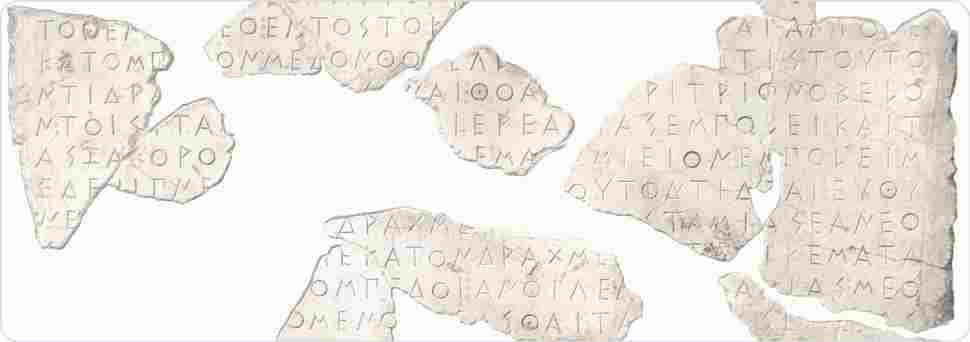
It is also able to consider the probability of the text originating from any of 84 different ancient regions, as well as producing a distribution of predicted dates across all decades from 800 BCE to 800 CE.
The company notes that Ithaca was able to achieve 62% accuracy in restoring damaged texts, 71% accuracy in identifying their original location, and can date texts to within 30 years of their ground-truth date ranges.
DeepMind has partnered with a number of leading scholarly institutions to develop its model, including the Department of Humanities of Ca' Foscari University of Venice, the Classics Faculty of the University of Oxford, and the Department of Informatics of the Athens University of Economics and Business.
The company has now open-sourced the code behind Ithaca, as well as the pretrained model and an interactive guide to help open it up to more users, as well as partnering with Google Cloud and Google Arts & Culture to launch a free interactive version of Ithaca for researchers, educators, museum staff and others.
“We believe this is just the start for tools like Ithaca and the potential for collaboration between machine learning and the humanities,” DeepMind concluded. “We hope that models like Ithaca can unlock the cooperative potential between AI and the humanities, transformationally impacting the way we study and write about some of the most significant periods in human history.”
You can forget about buying an electric VW, Audi or Porsche in 2022
If you’re keen to board the electric car bandwagon in 2022, you may have to look beyond models from brands under the Volkswagen umbrella.
According to a recent Financial Times report , the company’s CEO, Herbert Diess, has revealed that Volkswagen is “basically sold out [of] electric vehicles in Europe and in the United States” for the remainder of the year.
The production halt comes amid ongoing chip shortages – an issue that continues to affect everything from PS5 stock to the availability of printer ink cartridges – and means customers in the market for an electric VW, Audi, Porsche, Škoda or Seat aren’t likely to get their hands on one until 2023 at the earliest.
The Financial Times reports that VW is currently grappling with a lengthy waiting list of existing orders that it may struggle to fill before the year is out – a double-edged sword for both the health of the brand and the electric vehicle (EV) market as a whole.
On one hand, the high demand for models in VW’s ever-expanding electric fleet suggests a willingness on the part of consumers to move away from combustion engine models en masse. The company’s stifled production schedule, though, will inevitably slow its growth ambitions (in the US, in particular) and may encourage prospective customers to stick with their current vehicles or shop elsewhere.
VW sold just shy of 100,000 electric cars between January 1 and March 31 this year – up from 60,000 during the same period in 2021, but some 210,000 less than Tesla, for instance. The latter brand has led the EV charge for much of the last decade, though VW’s far broader electric model range (given the myriad brands under its control) bodes well for its future standing in the industry (the Audi e-tron and Porsche Taycan 4S , for instance, are among the best EVs we’ve tested).
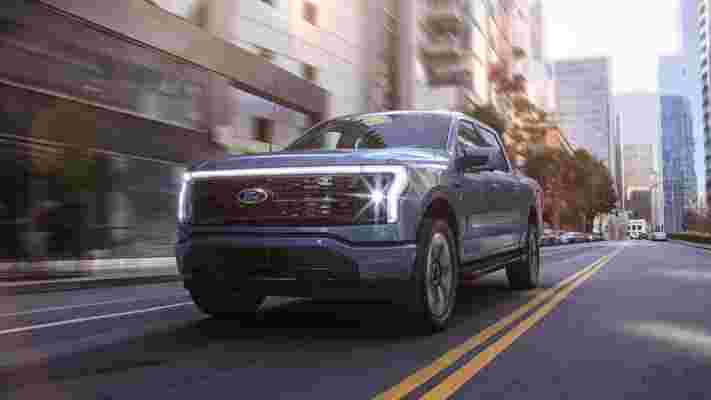
VW isn’t the only automotive brand feeling the chip shortage strain, either. As reported by The Verge in December, Ford has stopped taking reservations for its mega-popular F-150 Lightning electric pick-up, and the model is “no longer available for retail order” in 2022.
Having said that, VW’s situation seems a little more precarious. As mentioned, not only has the company dampened the hopes of prospective customers intending to purchase one of its EVs in 2022, but those who have already placed orders may be left equally disappointed by long delays.
Unlike Ford, though, the company hasn't entirely pulled the plug on vehicle reservations. "Customers can of course [still] place orders through our retailers for cars of the Volkswagen Group," a spokesperson for VW told TechRadar. "While delivery times may be longer than we would typically expect, for certain models deliveries can still be expected within 2022."
Those "certain models" will, however, likely depend on your region, and the company did caveat its statement with the following: "Due to a combination of high demand for our award-winning models, plus the restrictions of components sourced from Ukraine, and the global semiconductor shortage, for some customers car delivery times already indicate a 2023 delivery."
Our advice, then – if you're looking to pick up a shiny new electric car this year – is to turn to the similarly impressive South Korean brands for comfort. Both the Kia EV6 and Hyundai Ioniq 5 are among the best electric cars money can buy right now, while the Genesis GV60 is a slightly quirkier (though nonetheless impressive) alternative. Or, if you’ve got a spare six figures lying around, you could always opt for the "ultimate electric luxo-barge" Mercedes EQS saloon.
In truth, though, every major automaker will be feeling the strain of the global chip shortage and war in Ukraine – VW's gargantuan size just means the effects of both situations are felt a little more severely.
Via The Verge
Panasonic Lumix GH6 vs GH5 II: which vlogging camera should you buy?
Panasonic’s Lumix G range has given the world some of the best 4K video-focussed mirrorless cameras ever, with models like the Panasonic GH4 and Panasonic GH5 arguably reaching icon status amongst enthusiast filmmakers. And all this despite using a Micro Four Thirds sensor that’s significantly smaller than the full-frame sensors currently in vogue thanks to the likes of the Sony A and Canon EOS R ranges.
But say you’ve decided on a Micro Four Thirds model, recognising the advantages a smaller sensor can bring – a lighter and more compact body, more effective image stabilization and much smaller lenses. Which of Panasonic’s video stars do you pick: the Panasonic GH5 II, the updated, upgraded edition of a Lumix G classic; or the just-released Panasonic GH6, the most powerful camera in the Lumix G range, possessing a huge wealth of video options albeit in a larger body at a higher price?
Here we compare the design, specs, features and performance of the two cameras, picking out the main differences and hopefully letting you know which is the Panasonic Lumix G for you.
When bought body-only, the Panasonic GH6’s suggested retail price is $2,199 / £1,999 / AU$3,229, while the Panasonic GH5 II costs $1,699 / £1,499 / AU$2,699.
You can also buy each of the cameras with a kit lens. The Panasonic GH6 and a 12-60mm Leica DG lens retails for around $2,798 / £2,599 / AU$4,799, while the GH5 II with the same lens costs $2,298 / £1,899 / AU$3,059.
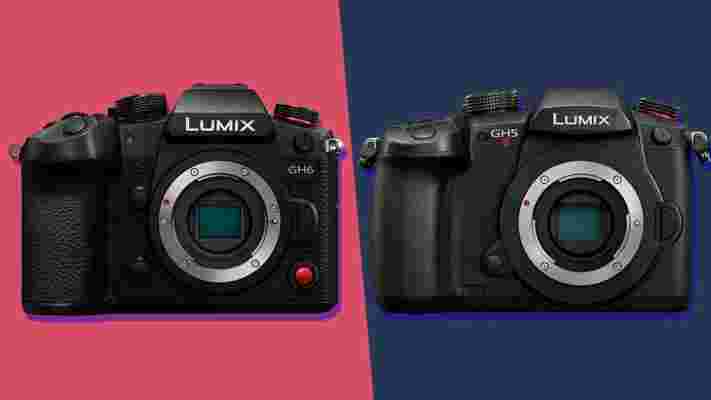
There’s a reasonable if not massive difference in the price of these cameras, which is unsurprising since they sit next to each other in Panasonic’s Lumix G hierarchy: the GH6 is the range-topping flagship, with the most powerful processor, sensor and widest range of features, while the GH5 II resides one notch down while still being pitched as a premium model.
As you’d expect from close stablemates, there’s not a huge difference between the design of these models.
Due chiefly to its built-in cooling system, the Panasonic GH6 is the larger and heavier of the two, but not by much: without a lens attached (but with a battery and SD card inside), the Panasonic GH6 weighs 823g to the Panasonic GH5 II’s 727g, and measures 138.4 x 100.3 x 99.6mm compared to 138.5 x 98.1 x 87.4mm. Once you’ve got a lens attached, the difference in bulk feels negligible. Both models are also dust and splash resistant, with rugged magnesium alloy frames.
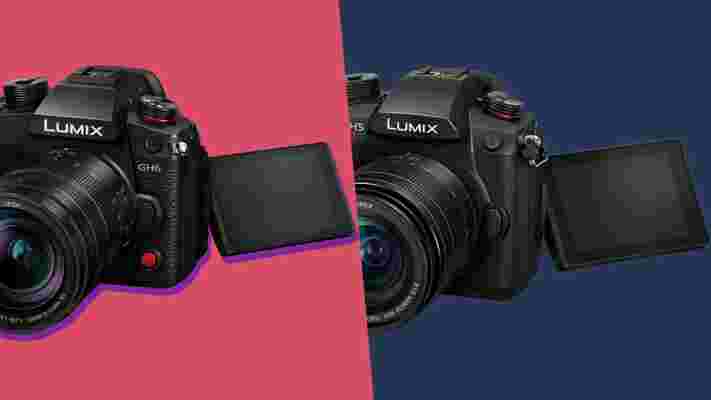
The two models have the same OLED viewfinder, with 3.68-million dots, and we couldn’t discern any real difference here. But when it comes to the rear touchscreen the Panasonic GH6’s tilting free-angle design adds an extra dimension of flexibility over the Panasonic GH5 II’s simpler free-angle design. The screen itself is the same (3-inch, 1.84-million dots, 3:2 aspect ratio) but the GH6’s can be angled a little more precisely.
| Panasonic GH6 | Panasonic GH5 II | |
| Size | 138.4 x 100.3 x 99.6mm | 138.5 x 98.1 x 87.4mm |
| Weight | 823g | 727g |
| Battery life (CIPA rating) | 360 shots | 400 shots |
Both models use the same 7.2V, 2200mAh battery, with the Panasonic GH6 offering slightly fewer shots and video on a single charge (likely due to the more powerful processor and the cooling system). According to Panasonic, when using an SD card the Panasonic GH6 can take 360 images on a charge, while the Panasonic GH5 II can take 400. Both cameras also support USB-C battery charging and power supply.
In terms of handling, there’s again not much difference between the two: controls are generally located in the same place. One thing to note is that the Panasonic GH6 has tally lights front and back to indicate when recording is taking place, while the GH5 II doesn’t. The GH6 has an extra front-mounted recording button too, which makes it easier to stop/start recordings when you’re in front of the camera.
One advantage Micro Four Thirds cameras have over their APS-C and full-frame rivals is that the small image sensor can be more easily stabilized. Both the Panasonic GH6 and GH5 II benefit from 5-axis in-body image stabilization, which automatically counteracts motion to deliver steadier shots, but the former’s version is a bit more effective: up to 7.5 stops’ worth of correction opposed to 6.5. Both setups work well, but the Panasonic GH6’s is just slightly superior.
As with all Panasonic mirrorless models, autofocus on both cameras comes courtesy of a contrast-based system. Most rival manufacturers favor a hybrid system that uses both contrast and phase detection to function, and in general that works a bit faster and more accurate than Panasonic’s pure contrast setup.
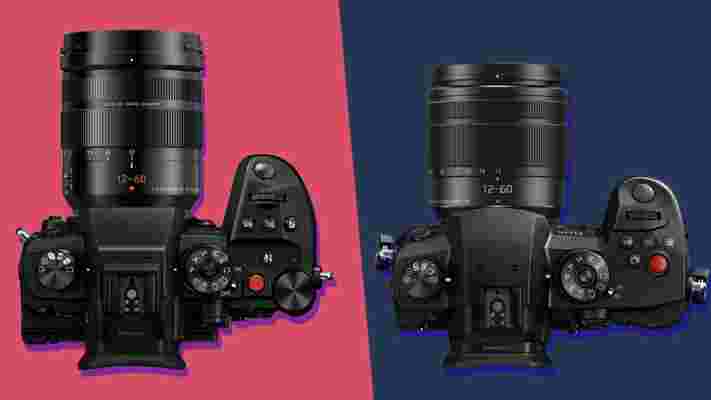
Still, with both cameras here using the same system and same specs, there’s little to tell between them, although having tested both we found the Panasonic GH6 seemed to be ever so slightly better at keeping a moving human face in constant sharp focus than the Panasonic GH5 II.
One feature the Panasonic GH5 II has that you won’t find on the pricier GH6 is video live streaming. If you want, you can set up the camera to stream in Full HD quality directly to YouTube, Facebook or any RTMP/RTMPS-based platform. This is worth noting if you’re coming from a content creation angle.
The Panasonic GH6’s main exclusive feature is its forced-fan cooling system, which prevents overheating during long, demanding video recording sessions. We should say that we’ve never had the Panasonic GH5 II overheat during our time with it, but Panasonic promises that, due to the cooling system, the GH6 will never have its recording time curtailed by overheating – the lengths of its recordings aren’t limited by anything other than storage space and power supply.
| Panasonic GH6 | Panasonic GH5 II | |
| IBIS | Up to 7.5 stops | Up to 6.5 stops |
| Burst shooting (electronic shutter) | 75fps | 12fps (60fps for 4K Photo) |
| Burst shooting (mechanical shutter) | 14fps | 12fps |
Speaking of storage, there’s a difference here too: the Panasonic GH5 II has two SD card slots, while the Panasonic GH6 has one SD slot and one CFexpress Type B slot. The latter, which can write at extremely high speeds, is required for some of the GH6’s more demanding video recording modes.
Both cameras have full-size HDMI outputs, mic and headphone ports and XLR microphone compatibility (via the optional DMW-XLR1 accessory), but the GH6 can record in stereo or four-channel audio, while the GH5 II is limited to stereo. The USB-C port on the GH6 is also 3.2 as opposed to the GH5 II’s 3.1, with transfer speed up to 10Gbps, and following a future firmware update it’ll be able to record direct to an external SSD.
Both cameras are video-focussed Micro Four Thirds hybrids possessing a wide range of recording options, but the Panasonic GH6 is by far the more advanced of the two models.
The Panasonic GH6 is based on a new 25.2MP sensor and an updated Venus processor while the Panasonic GH5 II uses a 20.3MP sensor and an older Venus (as previously seen on the Panasonic Lumix S1H full-frame camera).
These might sound fairly similar, but the extra power and resolution of the GH6 gives it the ability to record 5.7K Apple ProRes and 5.8K anamorphic at up to 60fps, C4K and 4K at up to 120fps and Full HD at up to 240fps. In contrast, the Panasonic GH5 II can recording 6K anamorphic at up to 30fps, and C4K, 4K and Full HD at up to 60fps. The extra frame rate options mean it’s easier to produce beautiful super-slow motion footage on the GH6 than it is the GH5 II.
The Panasonic GH6 also has more 10-bit recording modes and greater dynamic range, and overall its footage quality is just slightly cleaner and crisper. That’s not to say the Panasonic GH5 II is a slouch in this department, and much of the time you’d be hard pressed to tell the difference between video recorded by either.
| Panasonic GH6 | Panasonic GH5 II | |
| Sensor | 25.2MP 17.3 x 13mm Live MOS | 20.3MP 17.3 x 13mm Live MOS |
| Native ISO (extended) | 50-25600 | 100-25600 |
| Max shutter speed | 1/25000 sec | 1/16000 sec |
| Video | 5.7K/60fps | C4K/60fps |
| Slo-mo video | C4K/4K 120fps, Full HD 240fps | C4K/4K/Full HD 60fps |
Both cameras can take photographs too, of course – and while neither could be described as stellar stills machines, they can do a decent job in most situations, particularly with a good quality lens attached.
There’s not much difference here (both models have the similar ISO range: 50 to 25600 for the GH6, 100 to 25600 for the GH5 II) but the GH6’s slightly better resolution and faster burst mode gives it the edge. The GH6 can shoot full resolution stills at up to 75fps with its electronic shutter, while the GH5 II can manage up to 60fps but only when reducing its resolution to 4K quality.
There aren’t many surprises here: given their respective ages, prices and positions in Panasonic’s Lumix G range, we think these two cameras are right where they should be.
For the majority of users, even video-focussed content creators, the Panasonic GH5 II is probably enough: its image quality, image stabilization, build quality and general performance is solid, dependable and, occasionally, truly impressive.
The Panasonic GH6 is a much more powerful option, as you’d expect from its price and position as the Lumix G flagship model, and it’s truly a treat for more demanding filmmakers. Its wealth of recording options and the thoughtful touches like the tally lights, screen and front record button make it, for our money, Panasonic’s best video camera pound-for-pound.
But unless you’re truly obsessed with pixel-peeping, color grading and wringing every last drop of dynamic range out of your footage, you can probably make do with its slightly more affordable stablemate. If you’re all of the above, however, the Panasonic GH6 is a masterful movie-first hybrid.